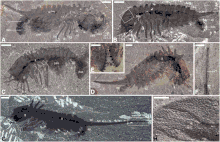Habelia
Habelia is an genus of extinct arthropod from the Middle Cambrian. Its fossils have been found in the Burgess Shale in British Columbia, Canada. Fifty-four specimens of Habelia are known from the Greater Phyllopod bed, where they comprise 0.1% of the community.[1] While previously enigmatic, a 2017 restudy found that it formed a clade (Habeliida) with Sanctacaris, Utahcaris, Wisangocaris and Messorocaris as a stem-group to Chelicerata.[2]
| Habelia Temporal range: Middle Cambrian | |
|---|---|
 | |
| Scientific classification | |
| Kingdom: | |
| Phylum: | |
| (unranked): | |
| Order: | Habeliida |
| Family: | Habeliidae |
| Genus: | Habelia Walcott, 1912 |
| Species: | H. optata Walcott, 1912 |

Fossils of Habelida optata
References
- Caron, Jean-Bernard; Jackson, Donald A. (October 2006). "Taphonomy of the Greater Phyllopod Bed community, Burgess Shale". PALAIOS. 21 (5): 451–65. doi:10.2110/palo.2003.P05-070R. JSTOR 20173022.
- Aria, Cédric; Caron, Jean-Bernard (December 2017). "Mandibulate convergence in an armoured Cambrian stem chelicerate". BMC Evolutionary Biology. 17 (1): 261. doi:10.1186/s12862-017-1088-7. ISSN 1471-2148. PMC 5738823. PMID 29262772.
Further reading
- Invertebrate Palaeontology & Evolution by Euan Neilson Kerr Clarkson
- Wonderful Life: The Burgess Shale and the Nature of History by Stephen Jay Gould
External links
- "Habelia optata". Burgess Shale Fossil Gallery. Virtual Museum of Canada. 2011.
- "Habelia? brevicauda". Burgess Shale Fossil Gallery. Virtual Museum of Canada. 2011.
- Habelia in the Paleobiology Database
This article is issued from Wikipedia. The text is licensed under Creative Commons - Attribution - Sharealike. Additional terms may apply for the media files.